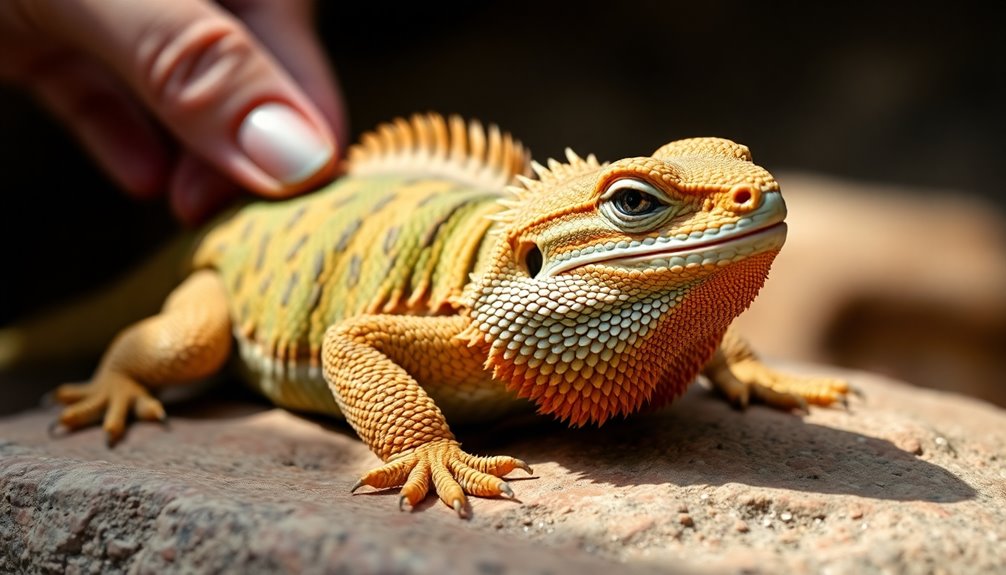To sex a bearded dragon, look for physical traits and behaviors that differentiate males from females. Males have two hemipenal bulges at the base of their tail, while females have one. Males also exhibit wider cloacal openings and larger femoral pores. Behaviorally, males may show aggression, like head bobbing, and they typically have broader heads. Wait until the dragons are at least 8-12 weeks old, as sex characteristics become clearer with maturity. Keep observing these signs, and you'll gain even more insight into identifying their gender effectively.
Key Takeaways
- Examine hemipenal bulges at the tail base: males have two, while females have one central bulge, becoming visible around 6-7 inches long.
- Check the cloacal opening: males have wider openings, whereas females possess narrower ones, aiding in distinguishing the sexes.
- Assess tail size: males typically have larger, thicker tails that can be half their body length; females have smaller, narrower tails.
- Observe head shape: males have wider heads with pronounced jowls, while females exhibit narrower heads and less defined jowls.
- Look for behavioral indicators; males display aggression and dominant postures, while females show submissive behaviors and may exhibit nesting habits.
Understanding Bearded Dragon Anatomy
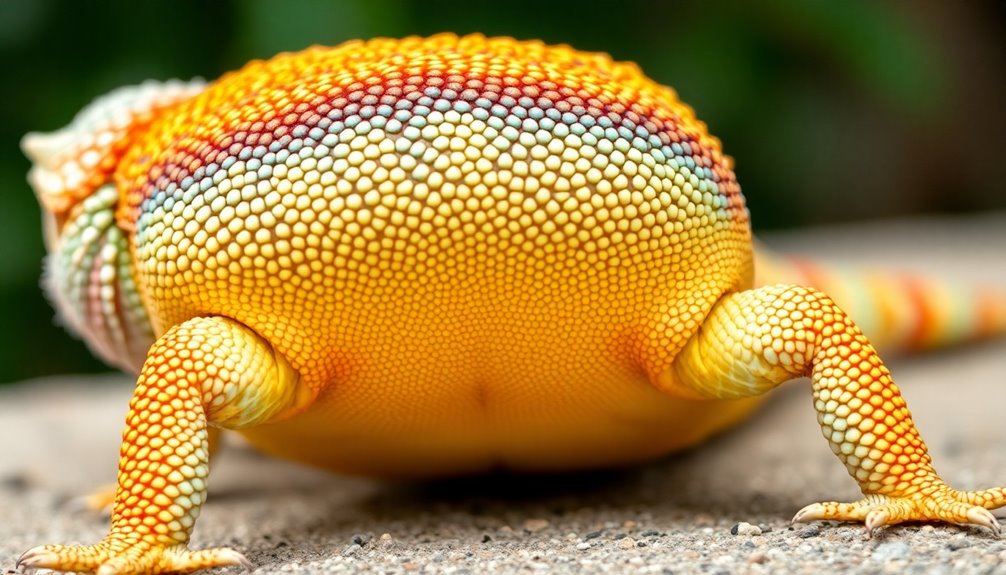
When you're trying to determine the sex of a bearded dragon, understanding its anatomy is key.
Look for hemipenal bulges; males have two distinct bulges on either side of their tail, while females feature a single central bulge. This visual cue can help you identify the sex quickly.
Additionally, pay attention to the cloacal opening: males have wider openings, whereas females have narrower ones.
You might also notice that males generally possess larger, thicker tails and wider heads with pronounced jowls. In contrast, females tend to have smaller, narrower tails and heads.
Finally, check for femoral pores, which are more prominent in males and develop around 12 months, further aiding in sex identification.
Key Physical Differences

When you're trying to determine the sex of your bearded dragon, pay attention to key physical differences.
Look for the distinct hemipenal bulges, the shape of the tail, and the overall size and head shape.
These features can help you easily identify whether your dragon is male or female.
Hemipenal Bulge Identification
Identifying the hemipenal bulges is essential for correctly sexing bearded dragons. Males display two distinct hemipenal bulges on either side of their tails, while females have a single central bulge at the tail base.
As your bearded dragon matures, typically around 6-7 inches long, these bulges become more pronounced in males. To check, gently lift the tail; if you see two bulges, you're looking at a male, while a single bulge indicates a female.
It's crucial to recognize that the size and visibility of the hemipenal bulges can vary with age, making it easier to accurately determine the sex of your bearded dragon in adults than in younger specimens.
Tail and Cloacal Features
The tail and cloacal features of bearded dragons offer clear indicators for sex determination. Males display two distinct hemipenal bulges on either side of their tail, while females have a single central bulge. This bulge difference is essential for accurate identification.
Additionally, the cloacal opening in males is wider compared to the narrower opening found in females. You'll also notice that males tend to have thicker, larger tails, which can account for nearly half of their total body length.
As they reach sexual maturity, typically around 8-12 months for males and 10-14 months for females, these features become more pronounced. Pay attention to the noticeable dent at the base of the tail, as females lack this characteristic.
Size and Head Shape
Understanding the size and head shape of bearded dragons can greatly aid in determining their sex. Males typically grow larger than females, averaging 18-24 inches in length, while females usually reach 16-22 inches.
Pay attention to head shape; males have wider, thicker heads with more pronounced jowls, whereas females have narrower heads and less defined jowls.
As they mature, these size differences become more noticeable, with males achieving sexual maturity between 8-12 months and females between 10-14 months.
Additionally, a male's tail is generally larger and thicker, contributing considerably to its overall size, while females have smaller, narrower tails.
Behavioral Indicators for Sexing

When you're observing your bearded dragon, pay attention to their behaviors, as these can reveal their sex.
Males often show aggression through head bobbing and hissing, while females tend to be more submissive, signaling readiness to mate with arm waving.
Additionally, watch for changes in beard color; males may darken their beards during courtship, a sign that's less common in females.
Male Aggression Displays
While observing bearded dragons, you'll notice that male aggression displays are key behavioral indicators for sexing these reptiles. Males often engage in head bobbing to assert territorial dominance, especially when challenged.
You'll also see them hiss and stomp their feet, particularly during mating season. One noticeable sign is the darkening of the male's beard during these aggressive encounters, indicating both territoriality and readiness to mate.
Unlike females, males typically exhibit more frequent and intense aggression displays. By observing these behaviors, you can confidently differentiate males from females, especially when looking at their sex organs and overall demeanor.
Understanding these male aggression displays can greatly assist in identifying the sex of your bearded dragon.
Female Submissive Behaviors
To identify female bearded dragons, you'll often notice their distinct submissive behaviors during interactions, especially with males.
Females typically exhibit arm waving in circular motions, signaling a non-aggressive stance. During courtship, you'll see them adopt a relaxed posture and avoid direct eye contact, further indicating their submissive nature.
Unlike males, females don't darken their beards, a common dominance display in male dragons. Additionally, during the breeding season, females may engage in digging or nesting behaviors, showing their readiness for mating.
Observing these behaviors can help you distinguish females from males, as males are generally more aggressive and territorial. Recognizing these submissive traits is essential for properly sexing your bearded dragon.
Beard Color Changes
Beard color changes in bearded dragons can reveal important clues about their sex, as males typically showcase more pronounced blackened beards during courtship or territorial displays.
While both sexes can darken their beards, you'll notice that males do this more frequently and intensely, especially when stressed or aggressive.
However, keep in mind that the intensity of beard coloration varies among individual dragons, making it a less reliable sole method for sex determination.
Females may also darken their beards, particularly under stress or during breeding interactions, but this is usually less pronounced than in males.
To accurately assess your dragon's sex, observe beard color changes alongside other physical characteristics, like hemipenal bulges.
Hemipenal Bulges Explained
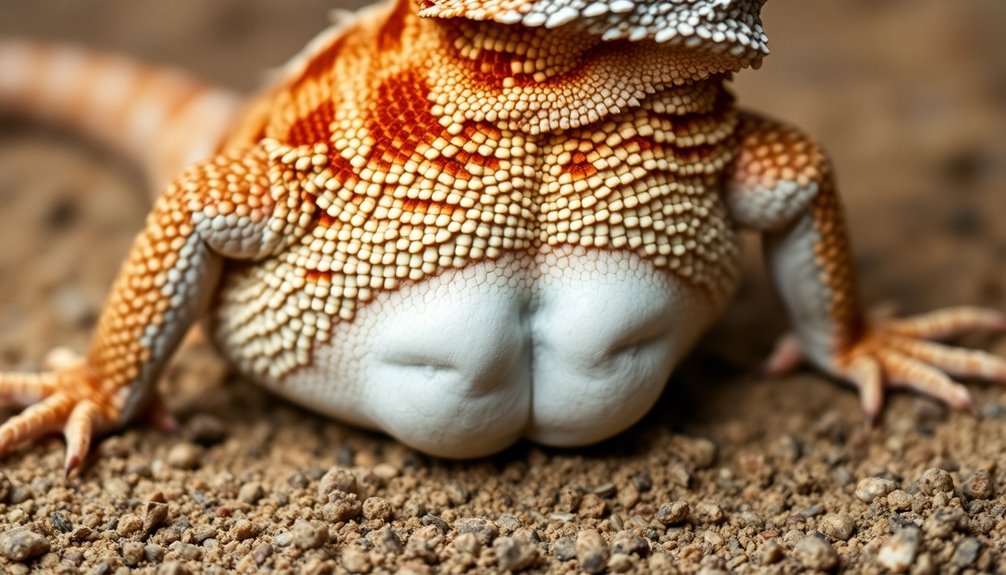
When you're trying to determine the sex of your bearded dragon, hemipenal bulges offer a clear clue.
Located at the base of the tail, these two distinct bulges indicate a male, while females display a single central bulge.
You'll typically notice hemipenal bulges in dragons that are at least 6-7 inches long and have reached maturity.
As a reliable sex indicator, these bulges are more pronounced in mature males, making them easier to spot.
To check for hemipenal bulges, gently lift the underside of the tail.
Keep in mind that size and visibility may vary with age and developmental stage, so younger dragons may present more of a challenge when it comes to accurate sexing.
Femoral Pores and Their Significance
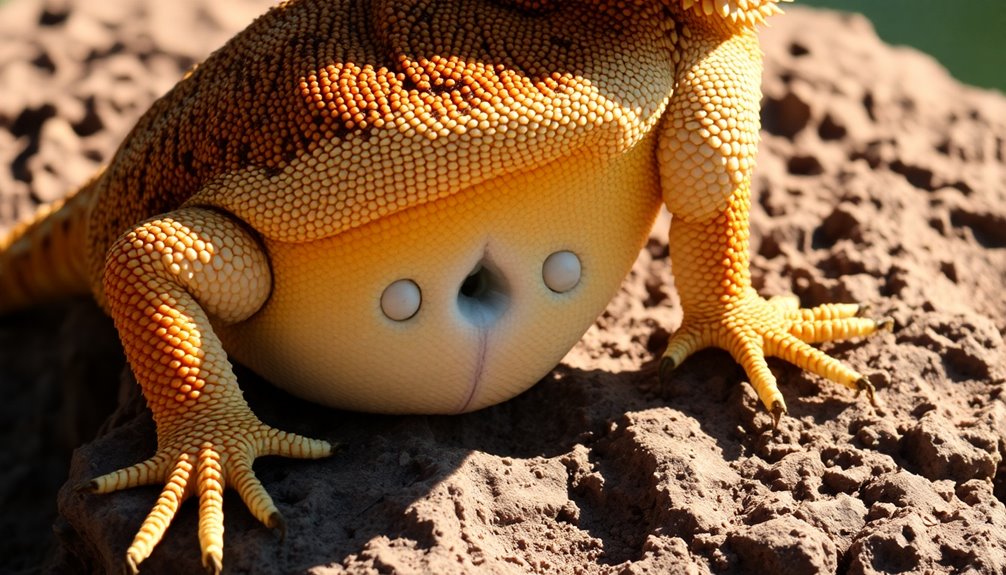
While checking the sex of your bearded dragon, femoral pores can provide valuable insights.
These preanal pores, located on the underside of the hind legs, are more pronounced in males than females. Typically, you'll notice the visibility of these pores developing around 12 months of age. Males will have larger and more distinct femoral pores, making them a useful indicator for sex determination.
However, it's important not to rely solely on this feature, as both sexes possess femoral pores. New owners might misidentify the sex based on pore appearance alone, so consider this method alongside other indicators.
Understanding the significance of femoral pores can enhance your ability to accurately identify the sex of your bearded dragon.
Safe Methods for Inspection
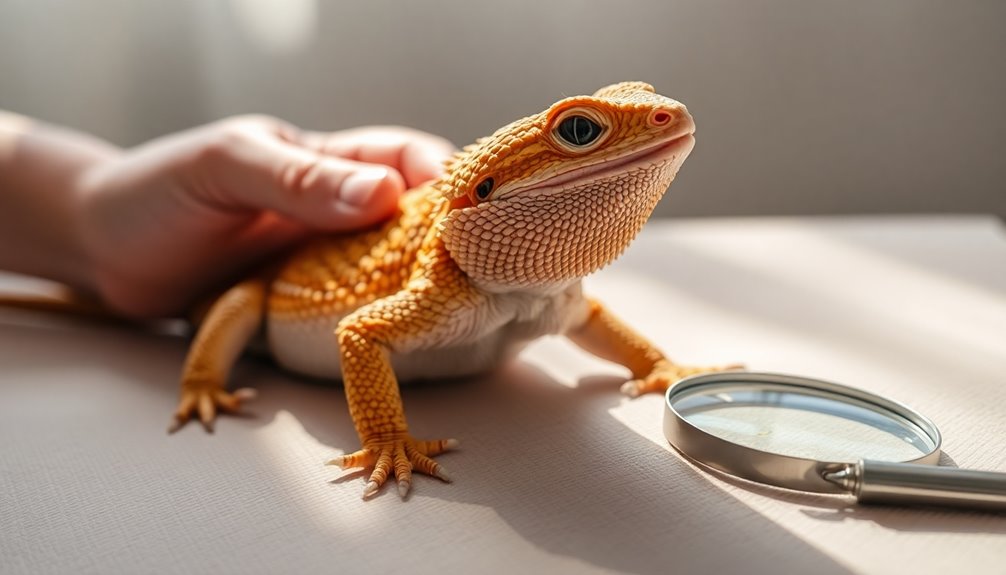
Inspecting your bearded dragon safely requires a careful approach. To determine its sex, gently lift the tail and observe the anatomical features. Males will display two bulges on either side of the tail, while females will show a single bulge at the center.
Using a flashlight can enhance visibility, helping you clearly identify hemipenal bulges and other characteristics. It's best to wait until your dragon is 8-12 weeks old for more accurate sexing, as younger dragons may lack distinct features.
Also, examine the femoral pores; males usually have more pronounced pores running from knee to knee. Avoid probing, as it can cause injury or infection; leave that to experienced veterinarians.
Common Misconceptions
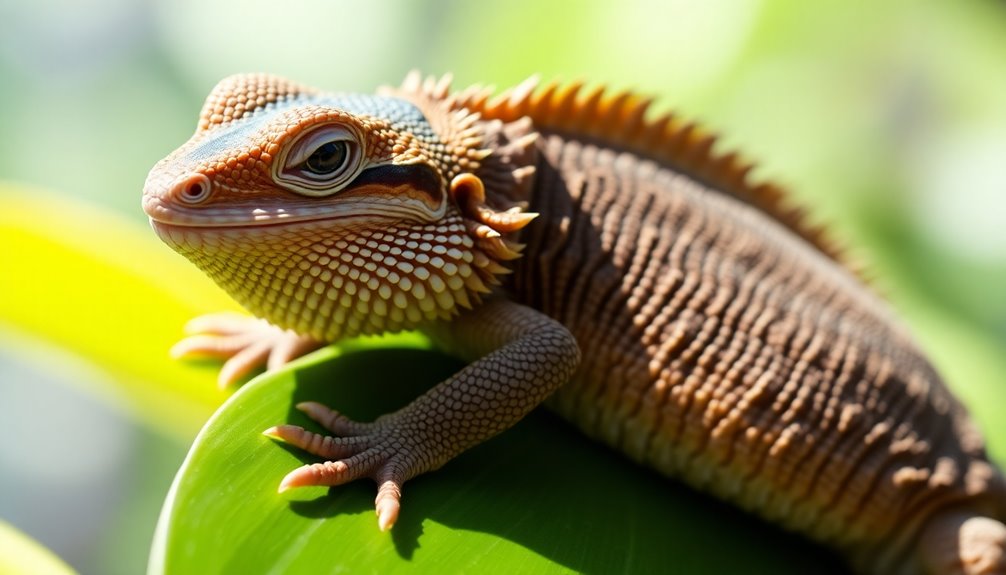
When it comes to sexing your bearded dragon, you might be misled by some common misconceptions.
Many people think that enlarged pores or tail bulges are definitive indicators of gender, but that's not always the case.
Plus, confusion often arises when trying to sex juveniles, as their characteristics can be tricky to interpret.
Enlarged Pores Misinterpretation
How can something as simple as a bearded dragon's femoral pores lead to confusion in determining its sex? Many new owners mistakenly believe that enlarged femoral pores are a clear sign of males, overlooking that both males and females have these pores.
While males typically have more pronounced pores, the size can vary greatly among individuals. This misinterpretation can lead to errors in sex identification, especially since younger dragons, under 12 months, may not display clear differences.
Relying solely on femoral pores for sexing can result in misidentification. It's crucial to take into account other physical characteristics, along with observing the pores, to accurately determine whether you have a male or female bearded dragon.
Juvenile Sexing Confusions
Misunderstandings about sexing juvenile bearded dragons often stem from over-reliance on physical traits that aren't fully developed yet. Many owners mistakenly think they can accurately identify the sex before the dragon reaches 12 months, but significant growth spurts complicate matters.
You might believe that all female bearded dragons are smaller than males, but size differences can be minimal and variable, leading to misidentification. The presence of femoral pores isn't a reliable indicator either, as they don't fully develop until around a year.
Additionally, it's a common misconception that the absence of visible hemipenal bulges means a juvenile is female; these bulges may not appear until the dragon matures, adding to the confusion around sex determination.
Tail Bulge Assumptions
Tail bulge assumptions can lead to significant confusion in sexing bearded dragons. Many people believe that all males will always display prominent hemipenal bulges, but younger males may not show a bulge in the center until they reach sexual maturity, usually around 6-7 inches.
Some owners think females have no bulges at all, though they possess a single central bulge that's less pronounced than the two bulges seen in males. Relying solely on size for identification is misleading, as both genders can be similar in dimensions.
Ultimately, the presence of hemipenal bulges isn't an infallible indicator of sex; you need to take into account overall anatomy and maturity for accurate identification. Understanding these misconceptions is key to proper sexing.
Age Considerations in Sexing

When you're trying to determine the sex of a bearded dragon, age is an essential factor to take into account.
Accurate sexing becomes more reliable after your dragon reaches 8-12 weeks, as physical characteristics, like hemipenal bulges, become more pronounced.
Before this age, younger dragons may not show these features clearly, making it tough to distinguish between sexes.
It's advisable to wait until your dragon is at least 6-7 inches long, as smaller individuals might exhibit misleading traits.
Keep in mind that males typically mature at 8-12 months and females a bit later, at 10-14 months.
Observing these age considerations will help guarantee that you make an informed decision about your bearded dragon's sex.
Breeding Readiness and Considerations

Once you've determined the sex of your bearded dragons, it's time to contemplate their breeding readiness. Guarantee both males and females are at least 18 months old and have reached full size; this promotes healthy breeding practices.
Pay attention to physical characteristics, like hemipenal bulges in males and the single bulge in females, to confirm their sex before breeding. Research the genetics and health of potential pairs to avoid hereditary issues and enhance the quality of offspring.
Creating a suitable breeding environment is essential—maintain proper temperature gradients, humidity levels, and provide hiding spots to reduce stress. Consulting with experienced breeders can also boost your knowledge and preparedness for successful breeding outcomes.
Resources for Bearded Dragon Owners
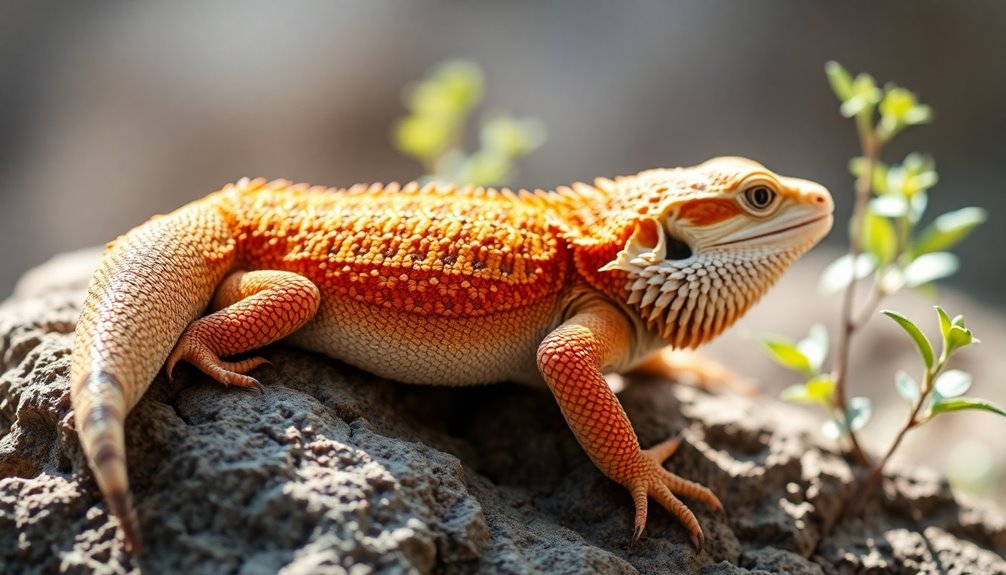
Owning a bearded dragon comes with a wealth of resources to guarantee you provide the best care possible. Numerous online forums and visual guides make it easy to learn how to sex your dragon.
Educational blogs by veterinarians offer expert insights on treating reptiles, helping you understand their physical traits and behaviors. Joining community support groups lets you see two perspectives: seasoned owners sharing tips and newbies asking questions.
Local herpetological societies often host workshops, providing hands-on experience in sex identification methods. Additionally, books and scientific publications dive deep into reptile anatomy and breeding, giving you a thorough understanding.
With these resources, you'll be well-equipped to care for and accurately identify your bearded dragon's sex.
Frequently Asked Questions
How Do You Tell if a Bearded Dragon Is Male or Female?
To tell if a bearded dragon is male or female, you'll want to look closely at its tail.
Males usually have two noticeable bulges underneath, while females have just one. Check the cloacal opening—males' are wider.
You might also notice pronounced femoral pores on males. Observe behavior too; males often display aggression, while females may wave their arms in submission.
Is It Okay to Kiss Your Bearded Dragon?
You might think kissing your bearded dragon is a sweet gesture, but it isn't a good idea.
Doing so can introduce harmful bacteria from your mouth, putting your pet at risk for infections.
Plus, reptiles don't experience affection like mammals do, so it won't mean anything to them.
Instead, focus on gentle handling and bonding through care.
Always wash your hands afterward to keep both you and your dragon safe and healthy.
Can Beardies Change Gender?
No, bearded dragons can't change gender. Their sex is genetically determined and doesn't change throughout their lives.
You might notice some behaviors or traits that seem gender-specific, but that's often due to environmental factors or hormones, not an actual gender change.
While rare, intersex conditions can occur, displaying both male and female characteristics, but these aren't true changes in gender.
Do Female Bearded Dragons Head Bob?
You might think head bobbing is exclusively a male thing, but surprise! Females do it too, though not as often.
When you see a female bobbing her head, it's usually more about asserting herself or acknowledging a male than showing aggression.
So, while you watch your pet's antics, remember that even the girls can get in on the action, albeit in their own subtle way.
Isn't that just like life?
Conclusion
In the world of bearded dragons, knowing how to sex them is like opening a secret door to their unique personalities. By understanding their anatomy, observing their behaviors, and recognizing the key physical differences, you can confidently identify your dragon's gender. Remember, each dragon has its own story to tell, and knowing whether you have a male or female can enhance your bond. So immerse yourself in their world, and nurture your connection with these fascinating creatures!

